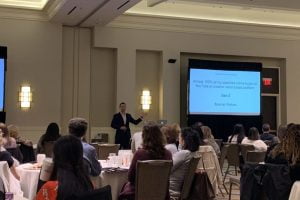Have you ever thought to yourself, “I should really start eating healthier,” or “Man, I’d like to lose a little weight,”or anything similar that caused you to pay closer attention to the nutritional value of your food? Now food companies know we all do this at some point, so they really play into appearing like the healthier option. Adding a few words to a label can trick the consumer into thinking the item is the healthier option. Take a gallon of milk for example. If you’re in the store shopping for milk and come across one that says “contains 10% fat,” and one that says “90% fat-free,” which are you more likely to grab? Our brains work in images, and so even if it isn’t a conscious thought, your brain perceives both labels on the milk, and decides 90% fat-free is the better option. Because one is basically saying, “contains fat,” and the other basically says “fat-free.” These two milks actually say the same thing, but one is framed in a more positive manner. It highlights what the customer is looking for when they are dieting or eating healthy. This technique is known as the framing effect.
The framing effect is a cognitive bias in which the brain makes decisions about information depending upon how the information is presented. This is a common technique used in marketing to influence and persuade shoppers to purchase a certain way. And it is a powerful tool you can use in your practice, as well. The framing effect has the power to help you stand out from your competition. If you just rely on processes, technology and methods to help you stand out, well that won’t work for long. The other orthodontists and dentists around you have the same degrees, similar braces and aligner options, similar chairs and tools, similar x-ray machines, etc. Most of these tools and technologies are pretty standard, so you have to utilize the framing effect to highlight your practice and to show potential patients why your practice is better than the competition.
White the framing effect is a psychological tool, it can actually be applied to your practice in a few simple and practical ways. Your practice needs to utilize the framing effect and learn how to articulate what sets your practice apart from the competition. Once you find what sets you apart, it is important each member of your team learns how to sell that to customers with each interaction. The good news is, you can likely take the information you are already providing patients with and slightly adjust the presentation of that information to get a different outcome. That’s the beauty of the framing effect!
Our NPG team takes pride in our ability to teach dentists, orthodontists, assistants, treatment coordinators, hygienists and more, how to showcase why their clinical skill sets are superior to other practices. Outsourcing to companies like New Patient Group, OrthoFi, Dental Monitoring, and Wright Chat will help you stand out amongst the competition. We can show you how to take the same information and showcase it in a different light in order to get a different outcome. Outsourcing to companies like the above will improve you social media presence, the new patient call and even proper financial presentation flow. With our many years of experience working in coaching and marketing, we can teach you the secret to mastering tactics like the framing effect, so you can stand out from the crowd and attract more patients. So, any money you spend on good marketing tools will only come back to you tenfold as new patients sign.
The great thing about the framing effect is it can be applied to almost anything in your practice, so it can be as simple as switching up the wording on the average braces timeline from, “Braces may take up to 3 years to correct crooked teeth,” compared to, “Braces can transform your smile in as little as 36 months!” Both phrases say the exact same thing, but they still somehow manage to send a completely different message. Let’s explore three other areas to which you can apply the framing effect.
Three Ways to Utilize the Framing Effect in Your Practice:
1. Charge no show fees
We have probably all been there. Forgot about hair cut, doctor’s appointment, or something of that nature, and when you finally did remember, it was too late to fully cancel the appointment, so you ended up paying a cancellation fee. Cancelation fees may seem like a crazy concept to some orthodontists and dentists. You might be thinking, “But our patients already pay so much for their treatment, we can’t also charge them for forgetting to cancel their appointment!” But if you think about it, your services and time are valuable, so charging a no show fee is very valid and understandable.
Maximizing the effectiveness of your no show policy is less about the actual fees and more about how the policy and fees are communicated to patients. This is where the framing effect comes into play. When you tell your patients about your cancelation policy and no show fee, make sure to highlight how this policy actually benefits them. Focus on placing more value and importance on the appointment and on the patient. Here is an example of what that communication to a patient can look like:
“Good Afternoon Mrs. Jones. We pride ourselves in offering the very best experience to each of our patients. We work tirelessly to make sure every appointment is efficient and timely, because we know we’re just one of the many tasks on your to do list. We work really hard to ensure an accurate schedule, so we can greet you with a warm and friendly hello the moment you walk through the door. That is what you and your family deserve! We don’t want other patients to impact your appointment time or experience. As a reinforcement tool, we do charge a no show fee and a cancellation fee. If you cancel 48 hours prior, you will be charged a $100 no show fee, but we know that’s not going to be you. We just have this policy to make sure nothing interferes with you and your family’s appointments.”
Without the framing effect, a no show fee and cancelation policy might come across as a sneaky way to earn more money from your patients, but once you reframe the scenario to show this policy is in place to prioritize them, it tells an enfríele different story. It’s truly a win-win because your patients feel valued, appointments are canceled on time, and those that were iffy about coming in the first place will ask you to remove them from the schedule. When patients cancel in a timely manner, your front office crew can call other patients and get those appointment slots filled, preventing you from losing money, and getting patients into the office sooner.
This is such a simple example of how the framing effect can paint a new, positive image in the minds of your patients. And all you have to do is rephrase a few sentences. You’ll get benefits with fewer no call no show scenarios with the added benefit of your patients feeling appreciated and respected.
2. Convince patients to complete their paperwork
Another aspect of your practice that could use a little framing effect magic is pre-appointment paperwork completion. Paperwork, as you have probably learned from our previous blog, referenced below, has to be a thoughtful process in your practice. The individuals that come into your office have preconceived ideas of paperwork. Get to your appointment fifteen minutes early, grab a clipboard, fill out multiple pages of questions, all for the associates to ask you the same questions during their appointment.
In order for your patients to prioritize paperwork, you have to change the look and utilization of paperwork in your practice. Say goodbye to the clipboards and try online applications your patients can fill out before their appointment. Make paperwork convenient and make sure your employees are utilizing the information gathered.
Your receptionist is responsible for introducing your practice’s process of paperwork completion. You have to break this preconceived idea of paperwork and that starts with the very first introduction from your receptionist. From the patient’s experience, most businesses or practices don’t have a convenient and efficient paperwork process. Your receptionist should use the framing effect to create a new image of paperwork in the minds of your patients similar to this example.
“Hello Mrs. Jones! I know you’ve probably filled paperwork out previously in other offices. And each time, you probably wonder what purpose completing that paperwork holds. Each time you visit a new office, they hand you the clipboard, or request you print the paperwork out at home and complete it before arriving at your appointment, but what is the point if no one reads the information you fill out? Well, our office is different. We have a commitment to excellence here, and we uphold that commitment in every detail, even our paperwork. I’m going to send you some digital forms, you can fill it out on your phone, it’s that easy!! Or you can complete them on your computer, whatever you prefer. But here’s the important part and where this really benefits you. We need this paperwork completed beforehand so we can verify your insurance prior to you arriving. We will also communicate those insurance benefits to you before your arrival. You won’t have any surprises once you get here and you can come to your appointment prepared. We will be sure to read all of your questions and comments to ensure you have an experience catered to you and your family’s needs. So can I have your commitment to getting that paperwork done prior to your appointment? Thank you so much, and please let us know if you have any questions beforehand!”
This is another great example of the power of the framing effect. And it’s something every patient has to do, but with this technique, you won’t have to badger them until they actually complete the paperwork. If you showcase the importance of something to patients and highlight how it wiil benefit them, they are much more likely to buy into what you’re saying.
**Visit the link to our previous NPG blog, Why your Receptionist is your New Treatment Coordinator, to learn more on teaching patients the value of completing paperwork
3. Use the right trigger words
When you see the term “trigger words,” there is probably an immediate negative connotation in your mind. But trigger words can actually be used in a positive light as well. If you use trigger words and the framing effect together, you can completely alter how your patients hear and receive what you’re saying to them.
A trigger word, as you probably know, is a word, phrase, or phrases that evoke a specific emotion in the reader, or listener. These emotions can work against you, ir if you’re using the framing effect, they can work in your favor.
A common example of a trigger word often used by Treatment Coordinators and doctors is the word recommend. What do you think of when you hear the word recommend? Well, a recommendation is really just a suggestion. When you recommend a course of action or a particular treatment to your patients, that puts the ball in their court. You’ve given them a suggestion, and they can decide if they want to take your advice or not. It’s not the best way to get patients on board with the treatment they probably really need.
Using the framing effect, take the trigger word recommend and replace it with a word like prescribe. When patients receive a prescription, they know in order to get better or to reach the results desired, they have to take that prescription. It’s less of a choice and more of an authoritative action that patients will see as necessary. You could say the same sentence, with only recommend and prescribe swapped for another in each, and you would have created two entirely different images in people’s minds.
“Mrs. Jones, I recommend that you start clear aligner treatment as soon as possible in order to correct your open bite.”
“Mrs. Jones, in order to correct your open bite, I am going to prescribe you to start clear aligner treatment as soon as possible.”
What kind of image does each sentence paint in your mind? Do you feel the sense of urgency from the second sentence that isn’t portrayed from the first? Does the first sentence seem optional whereas the second feels pretty final? These are the same images your clients portray, or could portray, if you utilize the right trigger words. Trigger words often work against us. They can sometimes serve as a warning, but if you frame them correctly, they can very much build the right emotions and images, and work in your favor.
You can easily utilize the framing effect and these three techniques every day in your practice. Once you start using the framing effect, you will not only streamline the flow of your office’s processes, but you will also significantly improve the experience of each of your patients. Remember to capitalize on your third party companies to help you in this process. Let us focus on your marketing and streamlining your office flow, so you can keep your focus on the clinical side of things.
Our team at New Patient Group is here to help you master techniques like the framing effect so every aspect of your practice can operate smoothly, and so you can outshine your competition. Continue listening to our podcast and reading along on our blog to see what expert advice we’ll have ready for you next time. Our goal is to guide you and your team to success in this rapidly changing economy.
Be sure to follow along with our podcast every month HERE!





